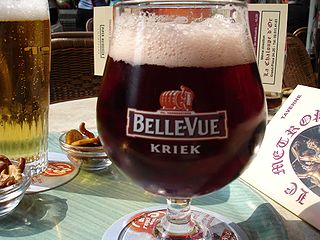
Kriek lambic is a style of Belgian beer, made by fermenting lambic with sour Morello cherries. Traditionally "Schaarbeekse krieken" from the area around Brussels are used. As the Schaarbeek type cherries have become more difficult to find, some brewers have replaced these with other varieties of sour cherries, sometimes imported.

Lambic is a type of beer brewed in the Pajottenland region of Belgium southwest of Brussels and in Brussels itself since the 13th century. Types of lambic beers include gueuze, kriek lambic and framboise. Lambic differs from most other beers in that it is fermented through exposure to wild yeasts and bacteria native to the Zenne valley, as opposed to exposure to carefully cultivated strains of brewer's yeast. This process gives the beer its distinctive flavour: dry, vinous, and cidery, often with a tart aftertaste.
Big Rock Brewery is a Canadian public company and the largest brewery that is based in Calgary, Alberta, Canada. Additional brewing operations are located in Vancouver, British Columbia; Etobicoke, Ontario; and Liberty Village in Toronto, Ontario. Big Rock distributes a variety of beers and ciders throughout Canada.
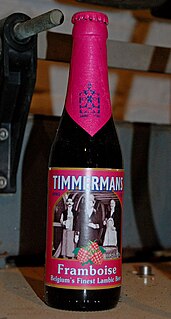
Framboise is a Belgian lambic beer fermented with raspberry.

Alken-Maes is a Belgian brewery created out of the 1988 merger of two small breweries, Maes located at Kontich-Waarloos and Cristal-Alken located at Alken. It was bought by Scottish & Newcastle in 2000, who were taken over by Carlsberg and Heineken in 2007.
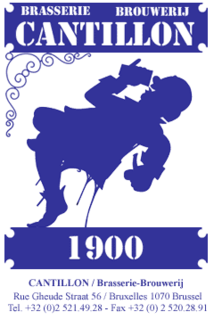
Brasserie-Brouwerij Cantillon is a small Belgian traditional family brewery based in Anderlecht, Brussels. Cantillon was founded in 1900 and brews exclusively lambic beers.

Belle-Vue Brewery is a brewery founded in 1913 in Molenbeek, Brussels by Philémon Vandenstock from nearby Itterbeek, which lies in a region known for its lambic type of beer. A variety of Belle-Vue lambic and fruit beers are produced in Sint-Pieters-Leeuw.

Beer in Belgium varies from pale lager to amber ales, lambic beers, Flemish red ales, sour brown ales, strong ales and stouts. In 2018, there were approximately 304 active breweries in Belgium, including international companies, such as AB InBev, and traditional breweries including Trappist monasteries. On average, Belgians drink 68 liters of beer each year, down from around 200 each year in 1900. Most beers are bought or served in bottles, rather than cans, and almost every beer has its own branded, sometimes uniquely shaped, glass. In 2016, UNESCO inscribed Belgian beer culture on their list of the intangible cultural heritage of humanity.
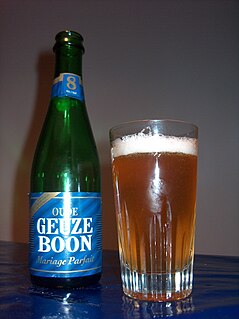
Gueuze is a type of lambic, a Belgian beer. It is made by blending young (1-year-old) and old lambics, which is bottled for a second fermentation. Because the young lambics are not fully fermented, the blended beer contains fermentable sugars, which allow a second fermentation to occur.

Brettanomyces bruxellensis is a yeast associated with the Senne valley near Brussels, Belgium.

Oud Beersel is a Belgian lambic brewery. It is a member of HORAL, whose main event is Toer De Geuze every two years.

3 Fonteinen is a Belgian brewery, specialized in geuze and kriek. The brewery is situated in Beersel, near Brussels and produces classic versions of both kriek and geuze.
The High Council for Artisanal Lambic Beers is a non-profit organisation that brings together the gueuze brewers and blenders of the Pajottenland and Zenne Valley in Belgium.

The term grand cru is used in a non-official context in the names of some products, particularly beer, chocolate, whiskey and cognac, to denote a high-quality product. While the term grand cru is well defined with respect to vineyards, its use with respect to other products is unregulated.
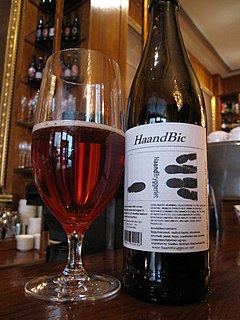
Sour beer is beer which has an intentionally acidic, tart, or sour taste. Traditional sour beer styles include Belgian lambics, gueuze and Flanders red ale, and German gose and Berliner Weisse.

Het Anker Brewery is a Flemish brewery in Mechelen, founded in 1471 by a community of Beguines. In 1872, the brewery was acquired by Louis Van Breedam, who renamed it Het Anker in 1904. Expanding its assortment from lager to ale, it began producing "Emperor beer" after World War II. In 1960 it renamed it "Gouden Carolus" after Charles V, Holy Roman Emperor. They opened a brasserie and a hotel, and in 2010 began producing a single malt whisky, distilled from the Gouden Carolus Tripel.
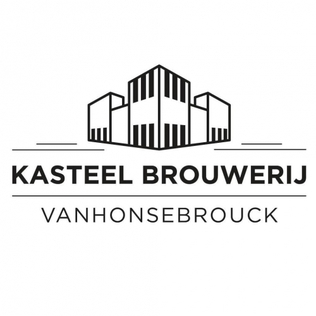
Van Honsebrouck is a Belgian brewery in Ingelmunster, Belgium. Founded in 1865 as Sint-Jozef Brewery, it was renamed to Brewery Van Honsebrouck in 1953. It is one of two breweries outside of Pajottenland to produce lambic beer.

de Garde Brewing is a brewery based in Tillamook, Oregon. de Garde is one of very few breweries in the United States to use all spontaneous fermentation, in which beer in a coolship takes in wild yeasts from the air; the beer is then aged, sometimes with fruit added, in foeders. In 2016, they won the fifth best brewery in the world award from RateBeer, and were named the best brewer in Oregon.

Tilquin is a Belgian lambic beer blendery based in Bierghes, Brussels, founded in 2009 by Pierre Tilquin. Tilquin is the only lambic blendery in the mainly French-speaking, southern region of Wallonia. Tilquin also is exclusively the only blendery that is allowed to blend of one, two, and three-year-old lambics with wort acquired from Boon, Lindemans, Girardin, and Cantillon breweries.

A barrel-aged beer is a beer that has been aged for a period of time in a wooden barrel. Typically, these barrels once housed bourbon, whisky, wine, or, to a lesser extent, brandy, sherry, or port. There is a particular tradition of barrel ageing beer in Belgium, notably of lambic beers. The first bourbon barrel-aged beers were produced in the United States in the early 1990s.




















